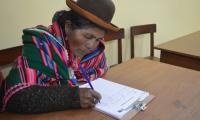Rebuilt website strengthens the realisation of indigenous peoples’ rights

Indigenous peoples account for over 476 million individuals. While representing more than six percent of the world’s population, they are nearly three times as likely to be living in extreme poverty, and many communities face discrimination, marginalisation and major challenges in enjoying their basic rights. Collecting data and documenting their human rights and development situation is a critical step towards enhancing the rights of indigenous peoples. In response to the need to document, monitor and address their situation, an online portal with a unique set of tools, called the Indigenous Navigator, was launched in 2017.
New features make the tools more user-friendly
Since then the Indigenous Navigator’s framework and tools have continuously been revised, and to better meet the needs and expectations of indigenous communities, its website and the data portal have recently been completely rebuilt.
Following consultation with indigenous partners and users, the Index calculations and the guidance on the survey have been updated. The portal now generates interactive visualisations of the collected data and comprehensive national and community reports. Further, the portal has been updated with an innovative index explorer, a new and much more accessible data explorer as well as a new survey module. All together these new features make the tools much more user-friendly and help Indigenous communities generate concrete data on their situation. Data which enhance their evidence-based advocacy for their rights.
Several communities and civil society organisations have so far benefitted from the enhanced tools. Among them OKANI, a community-based Indigenous NGO located in Cameroon in Africa.
Enhanced tools help communities claim their rights
“The Indigenous Navigator is an important tool for the [Indigenous] communities. It helps them and national organisations develop advocacy materials and claim their rights,” Timothée Emini, Indigenous Navigator programme coordinator from OKANI says.
Kapaeeng Foundation, a human rights organisation based in Bangladesh, experienced that various indigenous community leaders, by utilising data generated from the tools, have been able to mobilise and coordinate discussions with their respective government offices.
“Using documentation from the Indigenous Navigator, together with traditional advocacy approaches is a key example of how the Indigenous Navigator supports evidence-based advocacy at the community level,” the Indigenous Navigator Coordinator at Kapaeeng Foundation shares
- Asia Indigenous Peoples Pact (AIPP),
- Forest Peoples Programme (FPP),
- The Danish Institute for Human Rights,
- The International Work Group of Indigenous Affairs (IWGIA)
- The Tebtebba Foundation.
It is funded by the European Union
Monitoring all human rights instruments and the SDGs
A meticulous comparison between the United Nations Declaration on the Rights of Indigenous Peoples (UNDRIP) and other human rights instruments is built into the framework, in order to show how the UNDRIP provisions reflect rights enshrined in other human rights instruments. Thereby, data generated from the Indigenous Navigator is directly relevant for monitoring the full range of human rights instruments as they pertain to indigenous peoples. In order to ensure the tool is relevant for multiple purposes, the monitoring framework has taken into account that provisions of the UNDRIP are highly relevant for a rights-based implementation of the Sustainable Development Goals (SDGs). Indigenous Navigator data can, therefore, feed into SDG monitoring, planning and programming.
“The Indigenous Navigator enables a more systematic monitoring of the level of recognition and implementation of the rights of Indigenous Peoples, as guaranteed by the UNDRIP, the Indigenous and Tribal Peoples Convention,(also known as the ILO C169) and the SDGs,” Angela Agreda Farell, Indigenous Navigator Coordinator from the Centro de Estudios Jurídicos e Investigación Social (CEJIS), a Bolivian NGO that used the tools, says.
